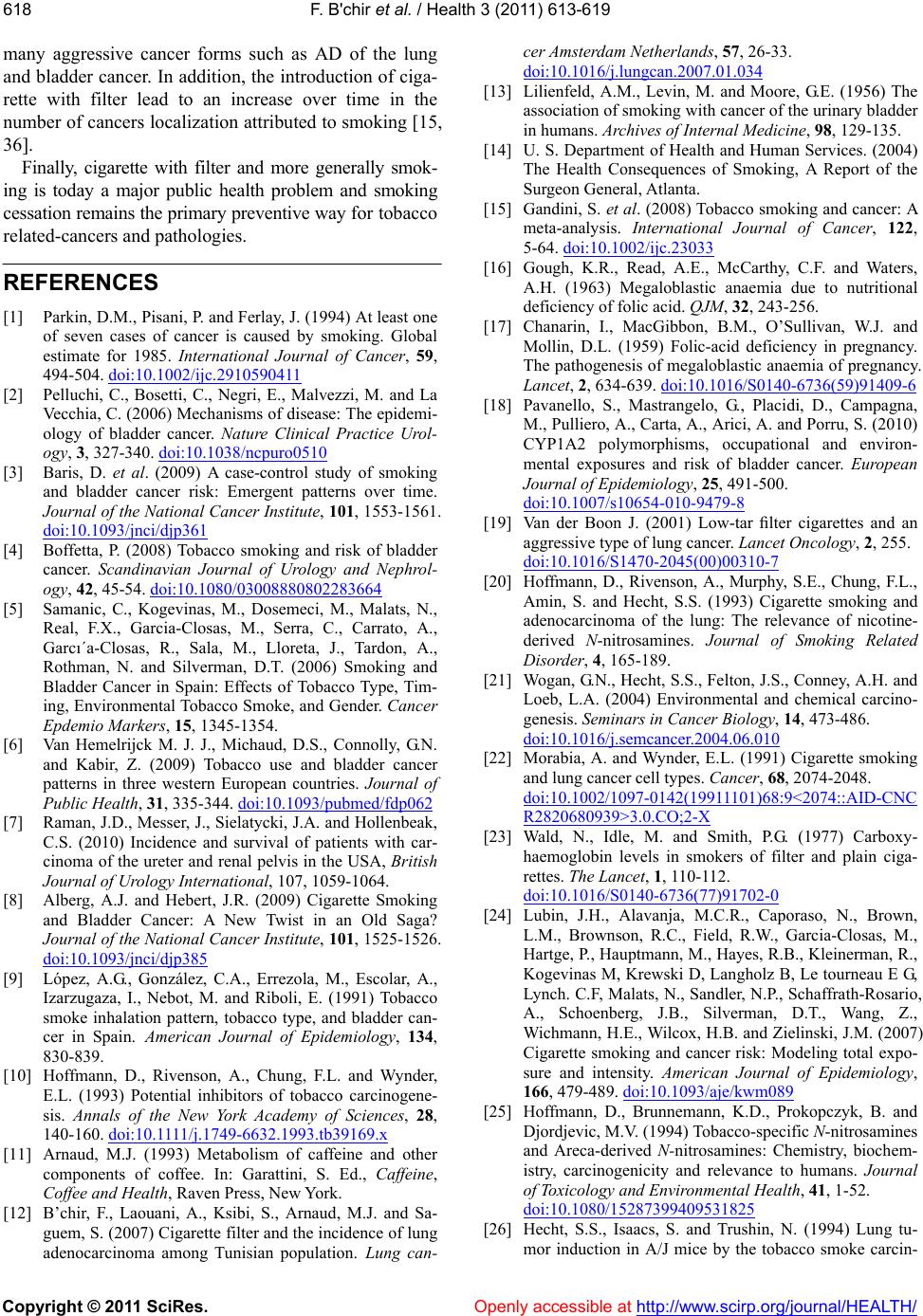
F. B'chir et al. / Health 3 (2011) 613-619
Copyright © 2011 SciRes. Openly accessible at http://www.scirp.org/journal/HEALTH/
618
many aggressive cancer forms such as AD of the lung
and bladder cancer. In addition, the introduction of ciga-
rette with filter lead to an increase over time in the
number of cancers localization attributed to smoking [15,
36].
Finally, cigarette with filter and more generally smok-
ing is today a major public health problem and smoking
cessation remains the primary preventive way fo r to ba c co
related-cancers and pathologies.
REFERENCES
[1] Parkin, D.M., Pisani, P. and Ferlay, J. (1994) At least one
of seven cases of cancer is caused by smoking. Global
estimate for 1985. International Journal of Cancer, 59,
494-504. doi:10.1002/ijc.2910590411
[2] Pelluchi, C., Bosetti, C., Negri, E., Malvezzi, M. and La
Vecchia, C. (2006) Mechanisms of disease: The epidemi-
ology of bladder cancer. Nature Clinical Practice Urol-
ogy, 3, 327-340. doi:10.1038/ncpuro0510
[3] Baris, D. et al. (2009) A case-control study of smoking
and bladder cancer risk: Emergent patterns over time.
Journal of the National Cancer Institute, 101, 1553-1561.
doi:10.1093/jnci/djp361
[4] Boffetta, P. (2008) Tobacco smoking and risk of bladder
cancer. Scandinavian Journal of Urology and Nephrol-
ogy, 42, 45-54. doi:10.1080/03008880802283664
[5] Samanic, C., Kogevinas, M., Dosemeci, M., Malats, N.,
Real, F.X., Garcia-Closas, M., Serra, C., Carrato, A.,
Garcı´a-Closas, R., Sala, M., Lloreta, J., Tardon, A.,
Rothman, N. and Silverman, D.T. (2006) Smoking and
Bladder Cancer in Spain: Effects of Tobacco Type, Tim-
ing, Environmental Tobacco Smoke, and Gender. Cancer
Epdemio Markers, 15, 1345-1354.
[6] Van Hemelrijck M. J. J., Michaud, D.S., Connolly, G.N.
and Kabir, Z. (2009) Tobacco use and bladder cancer
patterns in three western European countries. Journal of
Public Health, 31, 335-344. doi:10.1093/pubmed/fdp062
[7] Raman, J.D. , Messer, J. , Sielatycki, J.A. and Hollenbeak,
C.S. (2010) Incidence and survival of patients with car-
cinoma of the ureter and renal pelvis in the USA, British
Journal of Urology International, 107, 1059-1064.
[8] Alberg, A.J. and Hebert, J.R. (2009) Cigarette Smoking
and Bladder Cancer: A New Twist in an Old Saga?
Journal of the National Cancer Institute, 101, 1525-1526.
doi:10.1093/jnci/djp385
[9] López, A.G., González, C.A., Errezola, M., Escolar, A.,
Izarzugaza, I., Nebot, M. and Riboli, E. (1991) Tobacco
smoke inhalation pattern, tobacco type, and bladder can-
cer in Spain. American Journal of Epidemiology, 134,
830-839.
[10] Hoffmann, D., Rivenson, A., Chung, F.L. and Wynder,
E.L. (1993) Potential inhibitors of tobacco carcinogene-
sis. Annals of the New York Academy of Sciences, 28,
140-160. doi :1 0.1111 /j .1749-6632.1993.tb39169.x
[11] Arnaud, M.J. (1993) Metabolism of caffeine and other
components of coffee. In: Garattini, S. Ed., Caffeine,
Coffee and Health, Raven Press, New York.
[12] B’chir, F., Laouani, A., Ksibi, S., Arnaud, M.J. and Sa-
guem, S. (2007) Cigarette filter and the incidence of lung
adenocarcinoma among Tunisian population. Lung can-
cer Amsterdam Netherlands, 57, 26-33.
doi:10.1016/j.lungcan.2007.01.034
[13] Lilienfeld, A.M., Levin, M. and Moore, G.E. (1956) The
association of smoking with cancer of the urinary bladder
in humans. Archives of Internal Medicine, 98, 129-135.
[14] U. S. Department of Health and Human Services. (2004)
The Health Consequences of Smoking, A Report of the
Surgeon General, Atlanta.
[15] Gandini, S. et al. (2008) Tobacco smoking and cancer: A
meta-analysis. International Journal of Cancer, 122,
5-64. doi:10.1002/ijc.23033
[16] Gough, K.R., Read, A.E., McCarthy, C.F. and Waters,
A.H. (1963) Megaloblastic anaemia due to nutritional
deficiency of folic acid . QJM, 32, 243-256.
[17] Chanarin, I., MacGibbon, B.M., O’Sullivan, W.J. and
Mollin, D.L. (1959) Folic-acid deficiency in pregnancy.
The pathogenesis of megaloblastic anaemia of pregnancy.
Lancet, 2, 634-639. doi:10.1016/S0140-6736(59)91409-6
[18] Pavanello, S., Mastrangelo, G., Placidi, D., Campagna,
M., Pulliero, A., Carta, A., Arici, A. and Porru, S. (2010)
CYP1A2 polymorphisms, occupational and environ-
mental exposures and risk of bladder cancer. European
Journal of Epidemiology, 25, 491-500.
doi:10.1007/s10654-010-9479-8
[19] Van der Boon J. (2001) Low-tar filter cigarettes and an
aggressive type of lung cancer. Lancet Oncology, 2, 255.
doi:10.1016/S1470-2045(00)00310-7
[20] Hoffmann, D., Rivenson, A., Murphy, S.E., Chung, F.L.,
Amin, S. and Hecht, S.S. (1993) Cigarette smoking and
adenocarcinoma of the lung: The relevance of nicotine-
derived N-nitrosamines. Journal of Smoking Related
Disorder, 4, 165-189.
[21] Wogan, G.N., Hecht, S.S., Felton, J.S., Conney, A.H. and
Loeb, L.A. (2004) Environmental and chemical carcino-
genesis. Seminars in Cancer Biology, 14, 473-486.
doi:10.1016/j.semcancer.2004.06.010
[22] Morabia, A. and Wynder, E.L. (1991) Cigarette smoking
and lung cancer cell types. Cancer, 68, 2074-2048.
doi:10.1002/1097-0142(19911101)68:9<2074::AID-CNC
R2820680939>3.0.CO;2-X
[23] Wald, N., Idle, M. and Smith, P.G. (1977) Carboxy-
haemoglobin levels in smokers of filter and plain ciga-
rettes. The Lancet, 1, 110-112.
doi:10.1016/S0140-6736(77)91702-0
[24] Lubin, J.H., Alavanja, M.C.R., Caporaso, N., Brown,
L.M., Brownson, R.C., Field, R.W., Garcia-Closas, M.,
Hartge, P., Hauptmann, M., Hayes, R.B., Kleinerman, R.,
Kogevinas M, Krewski D, Langholz B, Le tourneau E G,
Ly nch. C.F, Malats, N., Sandler, N.P., Schaffrath-Rosario,
A., Schoenberg, J.B., Silverman, D.T., Wang, Z.,
Wichmann, H.E., Wilcox, H.B. and Zielinski, J.M. (2007)
Cigarette smoking and cancer risk: Modeling total expo-
sure and intensity. American Journal of Epidemiology,
166, 479-489. doi:10.1093/aje/kwm089
[25] Hoffmann, D., Brunnemann, K.D., Prokopczyk, B. and
Djordjevic, M.V. (1994) Tobacco-specific N-nitrosamines
and Areca-derived N-nitrosamines: Chemistry, biochem-
istry, carcinogenicity and relevance to humans. Journal
of Toxicology and Environmental Health, 41, 1-52.
doi:10.1080/15287399409531825
[26] Hecht, S.S., Isaacs, S. and Trushin, N. (1994) Lung tu-
mor induction in A/J mice by the tobacco smoke carcin-